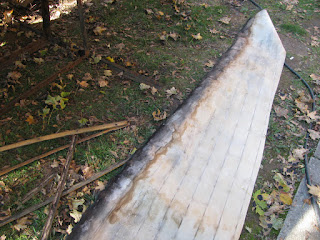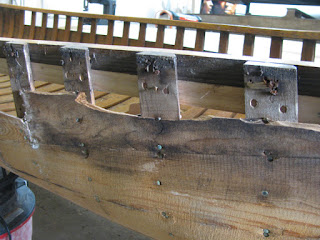A while back another Chestnut found its way into the shop, this one built during the last of Chestnuts days in the late 1970s in the Oromocto NB factory. From the early part of the 1900s the factory was located in Fredericton, but later relocated in a last-ditch effort to revitalize manufacturing and compete with the popularity of fiberglass and aluminum canoes. Indeed, they put their name on both, however the wood canoe was no longer in vogue. Roger MacGregor's book does a very in-depth explanation of this final period of The Chestnut Canoe Company, and the book is a tremendous amalgam of the company's history from before its inception.
This boat, while lacking some refinements characteristic of the period, is nonetheless in nice shape, with the wider, tapered ribs, one piece gunwales, and smooth hull.
Having been recovered once, and used sparingly on Lake Muskoka the boat has no broken ribs or deformations in the hull.
It does have the typical deck and gunwale tip rot, which occurs when boats are left upside down on the ends on the ground.
Straight, true hull 16' long and 33.5" wide.

Oversided iron deck ring, and slightly different decal displaying Oromocto rather than Fredericton, which was used throughout the company's history albeit with minor changes.
As collected, the canoe had been recovered in Verolite, which was used by several manufacturers as an alternative to traditonal filled and painted canvas. It is a vinyl impregnated cloth, with the color put into the coating and requiring no additional work once put on. Unfortunately, it traps moisture and has the effect of causing canoes to rot, typically at the gunwales and rib tips, and this boat was on its way to starting although not in an advanced state. Once dried out and sealed it will be fine.
Sloppy details typical of the later factory's method of production - a thwart that is barely shaped. Visible is the orignal thin coating of varnish, which will make removal very easy.
Evidence of having been recovered, the newer and larger cup washers were over top of smaller ones used for the inital installation of the keel.
Planking along the port side ends with very thin pieces, similar to that used on Bobs specials and lightweight canoes
The Starboard side is planked with a more appropriate thickness for this model and size of canoe - no doubt the factory 'used what they had', or more accurately what was likely within reach.
Where is this all going? This boat does display a lot of the characteristics of later Chestnut production, however its purpose here is the basis for a new project.
Some time ago we received a new lateen sail from a sailmaker who is the authority on historic sailing canoes and their rigs, Douglas Fowler. Located in Ithaca, NY he was the craftsman responsible for the sails on our 16/30s, and indeed can and will build any sails historic or modern.
A beautiful sail in a cream coloured dacron, it suggested we needed to find a boat for it.
A while back we were fortunate enough to acquirea Wolf Pond sailing canoe built by the Old Town Canoe Company, and sold to one of the great camps of the Adirondacks in 1928. An incredibly rare canoe, these were noteworthy for their sailing gear which included a centerboard trunk built into the boat, along with a 15lb bronze centerboard. Previous open canoes with sails had used leeboards, and these continued to be manufactured into the 60s and 70s. Very few of these boats, however, had been made despite it being offered as a regular item in catalogues. As often happens, the boat was moved on to a new owner, however its rarity and great sailing characteristics have inspired us to create a replica, in essence 'the sailing canoe Chestnut never built.'
Picking up the Old Town in NY
Visible is the seat with sailing ring, along with centerboard trunk between the thwarts.
Bronze centerboard and rudder
3/8 sheet of aluminum that will be the centerboard for this project. Have to resist the urge to polish it!
Another Wolf Pond (they were built using the 17' OTCA form) showing trunk and centerboard
Depth of centerboard, which will of course kick up upon striking bottom or an obstacle in the water
The Old Town OTCAs of the period had lovely sweeping sheerlines, high stems and generous beams. The Chestnuts, while great paddlers and safe, open water canoes, do not possess the same styling. Nevertheless, it will make a capable sailor with a beam of 34" and overall depth of 12.5" and 16' in length.
STAY TUNED!!
.
Couldnt leave it alone, cut off the steel hanger bolts, and underhung new rails. The ribs are fastened with steel nails, small diameter and heads so its just as well as most of them worked loose while pounding out the bolts.
Little upsweep in the sheer means no steaming, rails fit right in. Leaving them heavier as the boat will be sailed, so the more strength the better to combat the torsional stress they will get
A common fix on canoes, and we've done lots, is to splice pieces into the gunwale tips. Structurally they are just as strong, and as they dont extend back beyond the deck they do not weaken the rails. In fact, as with most later Chestnuts, the rails on this boat were spliced in the middle. These rails are now one piece white ash.
New rails were bent up and installed. Sheer dropped and center depth fell to 12.5", more appropriate for this model boat. Ends were kicked up to keep stem height, and introduce some sweep to the ends which always ends up looking better on a classic boat than a flat sheer.
Ends chopped out to make way for new upswept ends, along with much of top row of planking removed to allow ribs to be fastened to new gunwales.
New tops will be put on to cant ribs, as ends pick up a bit of height. Stems will be rebuilt with new tops grafted on.
Ribs fastened to new rails, making for a nice solid boat.
New gunwales fastened and installed. Old rails and rib tips get cut off.
As the old saying goes, 'never enough clamps'. Spend any time around any boat shop and this is almost universally true.




































